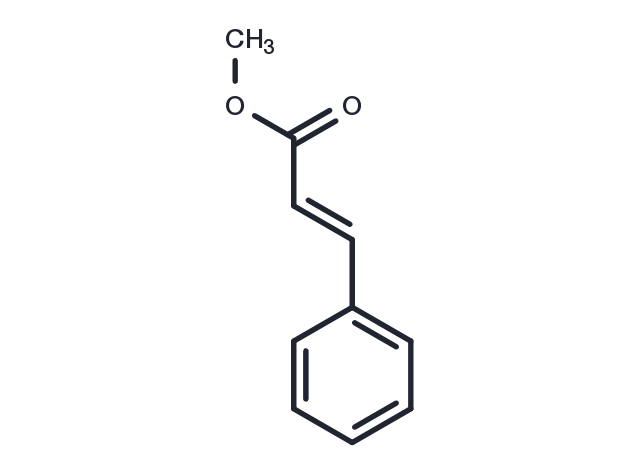Powder: -20°C for 3 years | In solvent: -80°C for 1 year


Methyl cinnamate, a tyrosinase inhibitor and a flavoring compound, has antimicrobial, antiadipogenic, vasorelaxant, and anti-inflammatory effects.

| Pack Size | Availability | Price/USD | Quantity |
|---|---|---|---|
| 500 mg | In stock | $ 42.00 | |
| 1 mL * 10 mM (in DMSO) | In stock | $ 46.00 |


| Description | Methyl cinnamate, a tyrosinase inhibitor and a flavoring compound, has antimicrobial, antiadipogenic, vasorelaxant, and anti-inflammatory effects. |
| In vitro | At 1-3000 μmol/L, the E-isomer of methyl cinnamate (E-MC) concentration-dependently relaxed endothelium-intact aortic preparations that had been precontracted with phenylephrine (PHE; 1 μmol/L), with an IC50 value (geometric mean) of 877.6 μmol/L (95% confidence interval (CI) 784.1-982.2 μmol/L). Over the concentration range 1-3000 μmol/L, E-MC relaxed K(+) -induced contractions in mesenteric artery preparations (IC50 314.5 μmol/L; 95% CI 141.9-697.0 μmol/L) with greater potency than in aortic preparations (IC50 1144.7 μmol/L; 95% CI 823.2-1591.9 μmol/L). |
| Source |
| Molecular Weight | 162.19 |
| Formula | C10H10O2 |
| CAS No. | 103-26-4 |
Powder: -20°C for 3 years | In solvent: -80°C for 1 year
H2O: Insoluble
DMSO: 30 mg/mL (184.97 mM)
You can also refer to dose conversion for different animals. More
bottom
Please see Inhibitor Handling Instructions for more frequently ask questions. Topics include: how to prepare stock solutions, how to store products, and cautions on cell-based assays & animal experiments, etc.
Methyl cinnamate 103-26-4 Chromatin/Epigenetic Microbiology/Virology PI3K/Akt/mTOR signaling Proteases/Proteasome Tyrosinase Antibacterial AMPK inhibit Bacterial Methyl 3-phenylpropenoate CaMKK2 3T3-L1 SREBP-1 Inhibitor activation AMP-activated protein kinase cells PPARγ natural flavor preadipocytes C/EBPα antimicrobial inhibitor
